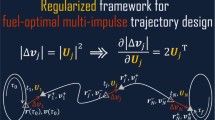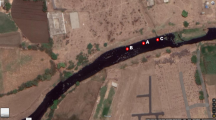Abstract
This paper describes a novel homotopy method to compute fuel-optimal trajectories starting from a time-optimal solution. The time-optimal problem is proposed to serve as a gateway for solving the minimum thrust problem. Homotopy is used to link the original low-thrust fuel-optimal problem with the minimum thrust problem. Two new variables are introduced in the dynamic model. The first is a logarithm of mass variable and the second is an acceleration magnitude variable. The analytic expression of the logarithm of mass co-state is solved. For the time-optimal problem, initial co-state of logarithm of mass can be expressed by thrust magnitude and transfer time. Then, the number of unknown initial co-states decreased. The effectiveness and optimality of the proposed method is validated through simulations of two rendezvous missions.









Similar content being viewed by others
References
Acikmese, B., Ploen, S.R.: Convex programming approach to powered descent guidance for Mars landing. J. Guid. Control Dyn. 30(5), 1353–1366 (2007)
Bertrand, R., Epenoy, R.: New smoothing techniques for solving bang-bang optimal control problems—numerical results and statistical interpretation. Optim. Control Appl. Methods 197, 171–197 (2002). https://doi.org/10.1002/oca.709
Caillau, J.B., Gergaud, J., Noailles, J.: 3D geosynchronous transfer of a satellite: continuation on the thrust. J. Optim. Theory Appl. 118(3), 541–565 (2003). https://doi.org/10.1023/B:JOTA.0000004870.74778.ae
Caillau, J.B., Daoud, B., Gergaud, J.: Minimum fuel control of the planar circular restricted three-body problem. Celest. Mech. Dyn. Astron. 114(1–2), 137–150 (2012). https://doi.org/10.1007/s10569-012-9443-x
Chen, S., Li, H., Baoyin, H.: Multi-rendezvous low-thrust trajectory optimization using costate transforming and homotopic approach. Astrophys. Space Sci. 363(6), 128 (2018). https://doi.org/10.1007/s10509-018-3334-x
Chi, Z., Li, H., Jiang, F., Li, J.: Power-limited low-thrust trajectory optimization with operation point detection. Astrophys. Space Sci. 363, 122 (2018). https://doi.org/10.1007/s10509-018-3344-8
Conway, B.A.: Spacecraft Trajectory Optimization. Cambridge University Press, New York (2010)
Dutta, A., Arora, N., Russell, R.P.: Peer-to-peer refueling strategy using low-thrust propulsion. J. Spacecr. Rockets 49(5), 944–954 (2012)
Haberkorn, T., Martinon, P., Gergaud, J.: Low-thrust minimum-fuel orbital transfer: a homotopic approach. J. Guid. Control Dyn. 27, 1046–1060 (2014). https://doi.org/10.2514/1.4022
Jiang, F., Baoyin, H., Li, J.: Practical techniques for low-thrust trajectory optimization with homotopic approach. J. Guid. Control Dyn. 35, 245–258 (2012). https://doi.org/10.2514/1.52476
Jiang, F., Tang, G., Li, J.: Improving low-thrust trajectory optimization by adjoint estimation with shape-based path. J. Guid. Control Dyn. 40(12), 3282–3289 (2017). https://doi.org/10.2514/1.G002803
Li, T., Wang, Z., Zhang, Y.: Double-homotopy technique for fuel optimization of power-limited interplanetary trajectories. Astrophys. Space Sci. 364(9), 144 (2019). https://doi.org/10.1007/s10509-019-3637-6
Pan, B., Lu, P., Pan, X., Ma, Y.: Double-homotopy method for solving optimal control problems. J. Guid. Control Dyn. 39(8), 1–15 (2016). https://doi.org/10.2514/1.G001553
Pan, B., Pan, X., Lu, P.: Finding best solution in low-thrust trajectory optimization by two-phase homotopy. J. Spacecr. Rockets 56(1), 283–291 (2019). https://doi.org/10.2514/1.A34144
Russell, R.P.: Primer vector theory applied to global low-thrust trade studies. J. Guid. Control Dyn. 30(2), 460–472 (2007)
Saghamanesh, M., Baoyin, H.: A robust homotopic approach for continuous variable low-thrust trajectory optimization. Adv. Space Res. 62(11), 3095–3113 (2018). https://doi.org/10.1016/j.asr.2018.08.046
Shirazi, A., Ceberio, J., Lozano, J.A.: Spacecraft trajectory optimization: a review of models, objectives, approaches and solutions. Prog. Aerosp. Sci. 102, 76–98 (2018). https://doi.org/10.1016/j.paerosci.2018.07.007
Sullo, N., Peloni, A., Ceriotti, M.: Low-thrust to solar-sail trajectories: a homotopic approach. J. Guid. Control Dyn. 40(11), 2796–2806 (2017). https://doi.org/10.2514/1.G002552
Taheri, E., Junkins, J.L.: How many impulses redux. J. Astronaut. Sci. 67, 257–334 (2020)
Taheri, E., Kolmanovsky, I., Atkins, E.: Enhanced smoothing technique for indirect optimization of minimum-fuel low-thrust trajectories. J. Guid. Control Dyn. 39(11), 2500–2511 (2016). https://doi.org/10.2514/1.G000379
Taheri, E., Li, N.I., Kolmanovsky, I.: Co-state initialization for the minimum-time low-thrust trajectory optimization. Adv. Space Res. 59(9), 2360–2373 (2017). https://doi.org/10.1016/j.asr.2017.02.010
Taheri, E., Atkins, E.M., Kolmanovsky, I.: Performance comparison of smoothing functions for indirect optimization of minimum-fuel low-thrust trajectories. In: 2018 Space Flight Mechanics Meeting (2018)
Tang, G., Jiang, F., Li, J.: Fuel-optimal low-thrust trajectory optimization using indirect method and successive convex programming. IEEE Trans. Aerosp. Electron. Syst. 54(4), 2053–2066 (2018). https://doi.org/10.1109/TAES.2018.2803558
Wang, Z., Grant, M.J.: Optimization of minimum-time low-thrust transfers using convex programming. J. Spacecr. Rockets 55(3), 586–598 (2018a)
Wang, Z., Grant, M.J.: Minimum-fuel low-thrust transfers for spacecraft: a convex approach. IEEE Trans. Aerosp. Electron. Syst. 54(5), 2274–2290 (2018b)
Yang, H., Li, S.: Fuel-optimal asteroid descent trajectory planning using a Lambert solution-based costate initialization. IEEE Trans. Aerosp. Electron. Syst. (2020). https://doi.org/10.1109/TAES.2020.2988625
Yang, H., Bai, X., Baoyin, H.: Rapid generation of time-optimal trajectories for asteroid landing via convex optimization. J. Guid. Control Dyn. 40(3), 628–641 (2017). https://doi.org/10.2514/1.G002170
Yang, H., Li, S., Bai, X.: Fast homotopy method for asteroid landing trajectory optimization using approximate initial costates. J. Guid. Control Dyn. 42(3), 585–597 (2019). https://doi.org/10.2514/1.G003414
Zhao, S.G., Gurfil, P., Zhang, J.R.: Initial costates for low-thrust minimum-time station change of geostationary satellites. J. Guid. Control Dyn. 39(12), 2746–2756 (2016). https://doi.org/10.2514/1.G000431
Zhu, Z., Gan, Q., Yang, X., et al.: Solving fuel-optimal low-thrust orbital transfers with bang-bang control using a novel continuation technique. Acta Astronaut. 137, 98–113 (2017). https://doi.org/10.1016/j.actaastro.2017.03.032
Acknowledgements
This research was supported by the National Natural Science Foundation of China (No. 11872034).
Author information
Authors and Affiliations
Corresponding author
Additional information
Publisher’s Note
Springer Nature remains neutral with regard to jurisdictional claims in published maps and institutional affiliations.
Rights and permissions
About this article
Cite this article
Li, T., Wang, Z. & Zhang, Y. A homotopy approach connecting time-optimal with fuel-optimal trajectories. Astrophys Space Sci 366, 11 (2021). https://doi.org/10.1007/s10509-020-03890-7
Received:
Accepted:
Published:
DOI: https://doi.org/10.1007/s10509-020-03890-7




